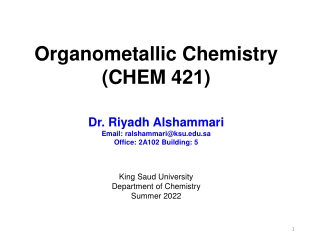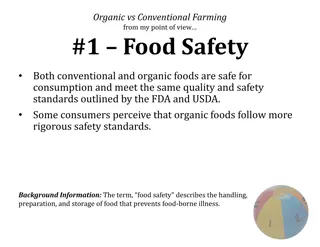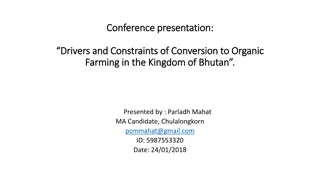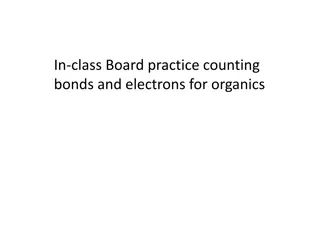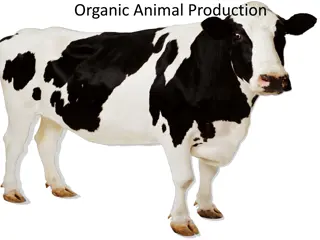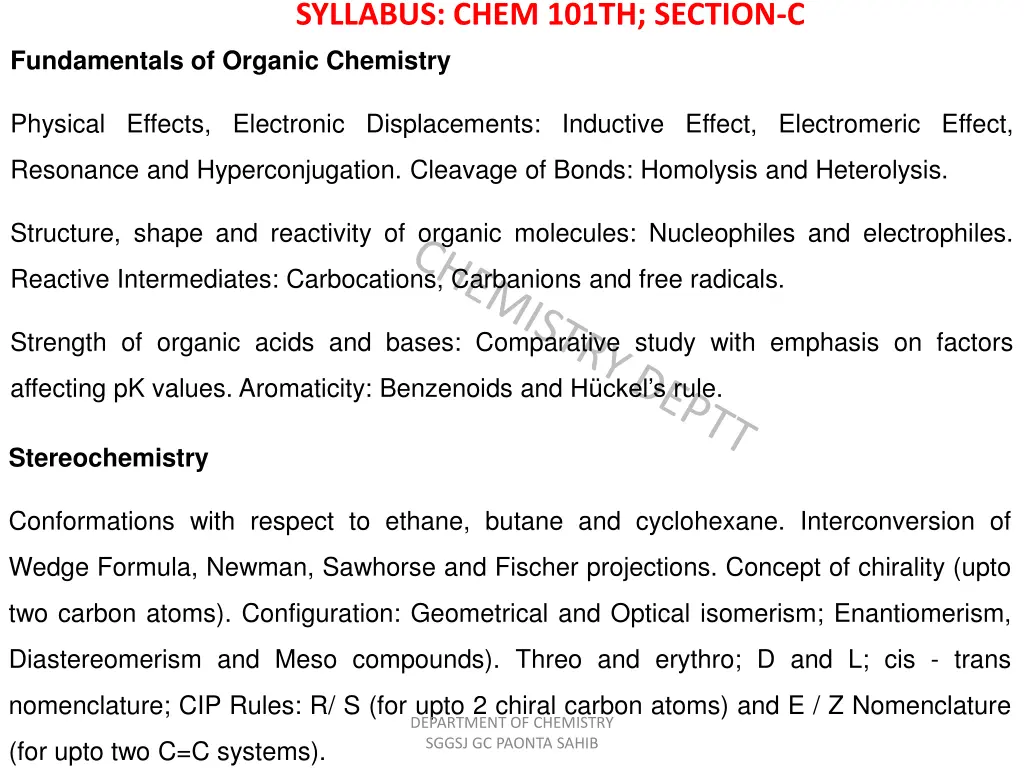
Fundamentals of Organic Chemistry: Physical Effects and Reactivity
Explore the core concepts of organic chemistry, including physical effects like inductive effect, electromeric effect, resonance, and hyperconjugation. Learn about bond cleavage, structure, reactivity, and the nuances of organic molecules. Dive into stereochemistry, configuration, and aromaticity to grasp the foundational principles of organic chemistry.
Download Presentation

Please find below an Image/Link to download the presentation.
The content on the website is provided AS IS for your information and personal use only. It may not be sold, licensed, or shared on other websites without obtaining consent from the author. If you encounter any issues during the download, it is possible that the publisher has removed the file from their server.
You are allowed to download the files provided on this website for personal or commercial use, subject to the condition that they are used lawfully. All files are the property of their respective owners.
The content on the website is provided AS IS for your information and personal use only. It may not be sold, licensed, or shared on other websites without obtaining consent from the author.
E N D
Presentation Transcript
SYLLABUS: CHEM 101TH; SECTION-C Fundamentals of Organic Chemistry Physical Effects, Electronic Displacements: Inductive Effect, Electromeric Effect, Resonance and Hyperconjugation. Cleavage of Bonds: Homolysis and Heterolysis. Structure, shape and reactivity of organic molecules: Nucleophiles and electrophiles. Reactive Intermediates: Carbocations, Carbanions and free radicals. Strength of organic acids and bases: Comparative study with emphasis on factors affecting pK values. Aromaticity: Benzenoids and H ckel s rule. Stereochemistry Conformations with respect to ethane, butane and cyclohexane. Interconversion of Wedge Formula, Newman, Sawhorse and Fischer projections. Concept of chirality (upto two carbon atoms). Configuration: Geometrical and Optical isomerism; Enantiomerism, Diastereomerism and Meso compounds). Threo and erythro; D and L; cis - trans nomenclature; CIP Rules: R/ S (for upto 2 chiral carbon atoms) and E / Z Nomenclature DEPARTMENT OF CHEMISTRY SGGSJ GC PAONTA SAHIB (for upto two C=C systems).
TOPICS COVERED IN THIS LECTURE Introduction to organic chemistry Physical Effects Electronic Displacements: Inductive Effect, DEPARTMENT OF CHEMISTRY SGGSJ GC PAONTA SAHIB
INTRODUCTION TO ORGANIC CHEMISTRY The term organic compounds was originally applied to compounds, such as sugar, alcohol, oils and fats, which are derived from vegetable or animal sources, that is, from living organisms. However, in 1828, Wohler synthesized urea, an organic compound present in the urine of animals, from ammonium cyanate, an inorganic compound obtained from ammonium sulphate and potassium cyanate. Modern definition of organic chemistry: Organic chemistry is now defined as chemistry of the compounds which contain carbon as an essential constituent. DEPARTMENT OF CHEMISTRY SGGSJ GC PAONTA SAHIB
Nature of bonding in organic compounds The carbon atom (atomic number 6), which is the common feature of all organic compound, has the electronic configuration 1s2, 2s2, 2px1, 2py1, 2pz0 Thus it has got four electrons in the valence shell. In order to acquire a stable noble gas configuration in its compounds, carbon should either loss or gain four electrons or alternately share four electrons. But the loss or gain of four electrons leading to the formation of C+4 or C-4 ions would require the supply of a very large amount of energy which is not available during ordinary chemical processes. This implies that carbon cannot form ionic bonds in its compounds and must form only covalent bonds. In other words, covalent bond is the bond of main importance in organic chemistry. The covalent bond itself may be polar or non-polar in nature depending upon the DEPARTMENT OF CHEMISTRY SGGSJ GC PAONTA SAHIB electronegativities of the bonded atoms.
PHYSICAL EFFECTS There are certain physical effects operating in organic molecules which strongly influence the physical properties and reactivity of organic compounds. Intermolecular forces are primarily electrostatic forces of attraction which hold together the individual molecules of the same or different substances. 1. Dipole-dipole Interactions 2. Van der Waals Interactions 3. Hydrogen Bonding DEPARTMENT OF CHEMISTRY SGGSJ GC PAONTA SAHIB
Dipole-dipole Interactions These forces operate between molecules containing polar covalent bonds. The positive end of one polar molecule attracts the negative end of another polar molecule. For example, in methyl chloride (CH3Cl) the relatively positive carbon of one molecule attracts the relatively negative chlorine of another molecule. As a result of these forces the polar molecules are held to each other more strongly than the non-polar molecules of comparable molecular masses. This is responsible for the difference in physical properties of the two types of compounds DEPARTMENT OF CHEMISTRY SGGSJ GC PAONTA SAHIB
Van der Waals Interactions These are veryweak forces of attraction between non-polar molecules. They may be defined as very weak forces of attraction between non-polar molecules which arise from the movement of electrons in atoms and molecules. That these forces are quite weak is evident from the fact that non-polar molecular substances and noble gases have very low boiling points. This can be possible only if the intermolecular forces are weak and are overcome by supplying very small amount of energy. Origin of van der Waals forces DEPARTMENT OF CHEMISTRY SGGSJ GC PAONTA SAHIB
Factors influencing van der Waals forces Number of electrons in the molecule. Size of the molecule (Surface area). Molecular shape (Surface area). Temperature and pressure: It may also be noted that for the same substance, the van der Waals forces are relatively stronger at low temperature and high pressure. DEPARTMENT OF CHEMISTRY SGGSJ GC PAONTA SAHIB
HYDROGEN BONDING: A compound containing highly polar covalent bond between hydrogen and a strongly electronegative atom like fluorine, oxygen and nitrogen in such a way that the hydrogen atom becomes partially positively charged while the more electronegative atom acquires partial negative charge (say Z). The positively polarized hydrogen of one molecule is attracted by the negatively polarized electronegative atom of the second molecule. Thus, this weak force of attraction is known as hydrogen bond. DEPARTMENT OF CHEMISTRY SGGSJ GC PAONTA SAHIB
ELECTRONIC EFFECTS IN ORGANIC COMPOUNDS An organic reaction is believed to occur by the attack of a reagent on a carbon compound called the substrate Substrate + Attacking reagent Products The attacking reagents may be either an electron-deficient or an electron-rich center and can attack the substrate molecules successfully only if the substrate possesses oppositely charged centers. This can be possible only if in the substrate molecule the displacement of bonded electrons occurs either partially or completely creating centers of low and high electron density. These displacements play a vital role in determining the reactivity of any molecule in a given reaction. These are mainly of four types 1. Inductive effect and field effect 2. Electrometric effects 3. Resonance or DEPARTMENT OF CHEMISTRY SGGSJ GC PAONTA SAHIB mesomeric effects and 4. Hyperconjugatton effects
INDUCTIVE EFFECT Whenever an electron-withdrawing atom such as CI is attached to the end of a carbon chain, the -electrons of the C-Cl bond are attracted by or displaced towards the more electronegative chlorine atom. As a result of this displacement, CI atom acquires a small negative charge (i.e., -) and C, acquires a small positive charge (i.e., +) as shown below; DEPARTMENT OF CHEMISTRY SGGSJ GC PAONTA SAHIB
INDUCTIVE EFFECT This effect can still be transmitted further but the intensity goes on decreasing considerably with distance. This type of -electron displacements along a saturated chain of atoms due to the presence of a polar covalent bond is called inductive effect or simply I-effect. Sometimes inductive effect is also called transmission effect or T-effect. NOTE: The inductive effect is almost negligible beyond two carbon atoms from the heteroatom. DEPARTMENT OF CHEMISTRY SGGSJ GC PAONTA SAHIB
TYPES OF INDUCTIVE EFFECT i) -I-Effect and (ii) +I-Effect -I-Effect: If the heteroatom attached to the end of the carbon chain is more electronegative than carbon or electron-withdrawing or electron attracting, the inductive effect is called-I-effect. For example X is more electronegative than C DEPARTMENT OF CHEMISTRY SGGSJ GC PAONTA SAHIB
+I-Effect: If the heteroatom attached to the end of the carbon chain is less electronegative than carbon, or electron- donating or electron-releasing the inductive effect is called +I-effect. The only electron-donating groups and low electronegativity are Li, Si, Mg, etc. and alkyl groups. DEPARTMENT OF CHEMISTRY SGGSJ GC PAONTA SAHIB
+I EFFECT So far the most important example of groups having electron-donating inductive effect is the alkyl group. The more highly substituted the alkyl group, the greater is probability to donate electrons and hence stronger is its +I-effect. DEPARTMENT OF CHEMISTRY SGGSJ GC PAONTA SAHIB
Characteristics of inductive effect Inductive effect involves only displacement of -electrons and occurs in polar single covalent bonds. The inductive effect is a permanent effect and cannot be reversed. The inductive effect decreases progressively as the distance between the carbon atom and the electron-withdrawing or the electron-donating atom or the group increases. The displaced electrons do not leave their orbital. Instead only little distortion of the orbital occurs which causes polarization as shown below DEPARTMENT OF CHEMISTRY SGGSJ GC PAONTA SAHIB
PROPERTIES OF INDUCTIVE EFFECT Some important properties of inductive effect are discussed below Stability of reactive intermediates: The relative stability of host radicals, carbocations 1. and carbanions can be explained on the basis of inductive effect. Polarity of covalent bonds and dipole moment of organic compounds: an Inductive 2. effect causes polarization of covalent bonds between two dissimilar atoms and definite dipole moment. The magnitude of this dipole moment, however, depends upon Electronegativity difference: Greater the electronegativity difference between the two I. atoms forming the covalent bond, more polar is the covalent bond and hence greater is the dipole moment of the organic compound DEPARTMENT OF CHEMISTRY SGGSJ GC PAONTA SAHIB
Polarity . Orientation of polar covalent bonds: If a molecule has two or more covalent bonds, the actual dipole moment of the molecule depends upon their orientation in space. In other words, the actual dipole moment of the molecule is a vector sum of all the individual bond moments. DEPARTMENT OF CHEMISTRY SGGSJ GC PAONTA SAHIB
IMPORTANT RULE Stability of reactive intermediates: The common rule followed is: GREATER THE DISPERSAL OF CHARGE ,GREATER THE STABILITY. GREATER THE INTENSIFICATION OF CHARGE ,LESSER THE STABILITY. DEPARTMENT OF CHEMISTRY SGGSJ GC PAONTA SAHIB
ON SIMILAR LINES AS YOU HAVE STUDIED INDUCTIVE EFFECT ,YOU HAVE TO STUDY THE ELECTROMERIC EFFECT,RESONANCE EFFECT AND HYPERCONJUGATION AS DISCUSSED IN THE OFFLINE CLASS . DEPARTMENT OF CHEMISTRY SGGSJ GC PAONTA SAHIB

